

This site uses non-intrusive cookies to enable us to provide a better user experience for our visitors. No personal information is collected or stored from these cookies. The Society's policy is fully explained here. By continuing to use this site you are agreeing to the use of cookies.
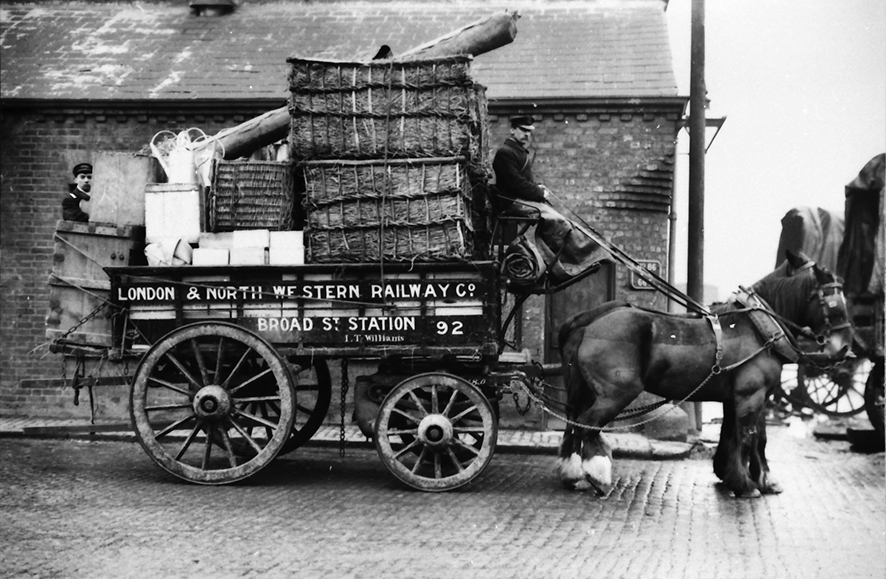
A heavily loaded LNWR pair horse van No. 92 allocated to Broad Street station about to set off on
its round. A figure standing on the tail board appears from behind packing cases. (HMRS AAD024)
Those railways reaching to London needed to have goods, as well as passenger stations in the City, together with the Docks, if they could. When the London & Birmingham Railway opened for business in 1837, its goods facilities were located on the then fringes of the capital at Camden Goods Station (Chalk Farm). To gain access to London Docks, in 1846 it joined forces with the East & West India Dock and Birmingham Junction Railway to construct a line from Camden to Poplar. An extension from Kingsland (Dalston) to Broad Street opened on 31 October 1865. The North London Railway, as the E&WID&BJR had become in 1853, shared the use Broad Street Passenger Station equally with the LNWR, successors to the L&BR, which had running powers to the station(1 & 2).
Broad Street Goods Station and the approach lines from New Inn Yard Junction was owned and operated by the LNWR. It was opened on 18 May 1868, becoming a vast facility as behoves a city location and remained in business for just over a century, closing on 27 January 1969(3). Bearing in mind that the passenger station and the approach lines from the north, in contrast to the adjacent GER Liverpool Street station, were elevated above street level on arches, the goods station consisted of the entire under-croft below the passenger platforms and extended considerably to the north-west(4). At the lower, street level, the portion below the passenger platforms was within Arches 554 to 567, while the extension to the west side was beneath girders supported on pier extensions made up of two triple and one pair of columns. Rail access to the goods station was by means of nine reception sidings parallel to the passenger station leading from the approach lines. These were interconnected by wagon turntables and transverse lines, worked by capstan, leading to three 25-ton hoists which enabled wagons to be lowered to ground level, from where further wagon turntables served 21 lines. Within an arch span, each pair of lines had a landing between and upon which were numerous cranes.
Two of the transverse lines from the reception sidings at the upper level, however, continued westwards across an opening, the site of one/two of the photographs, and passed an adjacent goods warehouse. Thereafter, it bridged Finsbury Avenue and, by means of two 20-ton hoists, served a further goods station facing Wilson Street between the Roman Catholic Church and Broad Street Station Dwellings, within which were four lines at street level(5).
As well as a complete circuit of the under-croft, on the west side a line extended northward, crossing Skinner Street and Primrose Street, which passed beneath Bridge Nos. 541 and 536, to a further depot in a triangle of land between Appold Street and Worship Street. For the majority of the goods station's life, inwards collection and onwards delivery by road depended on the humble horse and cart. To accommodate these, extensive stables and other facilities were located within the arches just to the north of the station in Arches Nos. 551 to 531. Within Arches Nos. 546 to 551 were over 300 stalls and ten loose boxes, together with the horse foreman's office and a blacksmith's shop. Arches Nos. 545 to 543 contained ten boilers supplying steam to engines, dynamos and hydraulic accumulators. Between Skinner Street and Primrose Street a couple of arches housed another 34 stalls and the wheel-right's store, with his shop immediately outside. A further hundred stalls and nine loose boxes were to be found in Arches Nos. 524, 531 and 535, between there and Worship Street, beyond which was a coal depot.
During the interval between the preparation of the two surveys in 1921 and 1957 upon which Figures 1 to 3 are based, it appears a number of the short lengths of track at street level in Worship Street Goods Yard had been removed leaving merely the curved line round the perimeter and one short stub supplied by a wagon turntable. In their place an overhead travelling gantry crane extending over the first six sidings on the viaduct, but also projecting over a short distance to the north-west, has been installed. This would presumably enable loads to be transhipped between wagons at high level and road vehicles in the yard at street level.
To the north-west of the viaduct, scattered along the perimeter wall were numerous small huts and buildings including: a paraffin store, meter cupboard, Police huts, small offices, loco store yard, manure pits, tarpaulin sheet store, harness room, Pickford's order office, time keepers' office, closets and urinals, together with weigh bridges. In the vicinity of the under-croft and associated buildings, as well as the already mentioned hoists, capstans and cranes, were general, chief foreman's, clerks', delivery, checkers and cartage offices; accommodation for the Permanent Way Department; fitters' shop; carmen's dining room, kitchen, store and billiard and reading room; weighing machines; stair cases, trap doors and lifts; hydrants, fire and ambulance stations
The dependence on small diameter wagon turntables, 20/25-ton hoists and tight curves for the movement of wagons meant that locomotives will have been barred from within the goods station and anyway a fire hazard. Instead movement will have been carried out by means of ropes and about two dozen capstans. Adjacent to each line was a landing platform, usually extending to the roadway where carts will have been backed up. On the landings were in total about 160 30-cwt and 2-ton cranes, together with a small number of 5 and 10-ton capacity elsewhere. The traffic handled at this goods station included merchandise and perishable goods, such as fish from Fleetwood. Bulk loads such as coal were dealt with at the Worship Street Coal Yard to the north. Merchandise would generally arrive in wagon loads or less and be conveyed loose, or bundles, in sacks, bales, cartons, boxes, barrels or packing cases. Most would have been man-handle able, but barrows and cranes were on hand to ease the task.
The relationship and interdependence of the two companies became so entrenched that in December 1908, an agreement was made between the LNWR and NLR, whereby, although the NLR continued to exist as a separate corporation, its day to day working came under the supervision of officers of the former. In anticipation of Grouping, the NLR, together with the Lancashire & Yorkshire Railway amalgamated with the LNWR in December 1921. All, of course, became part of the London, Midland & Scottish Railway from 1 January 1923(6).
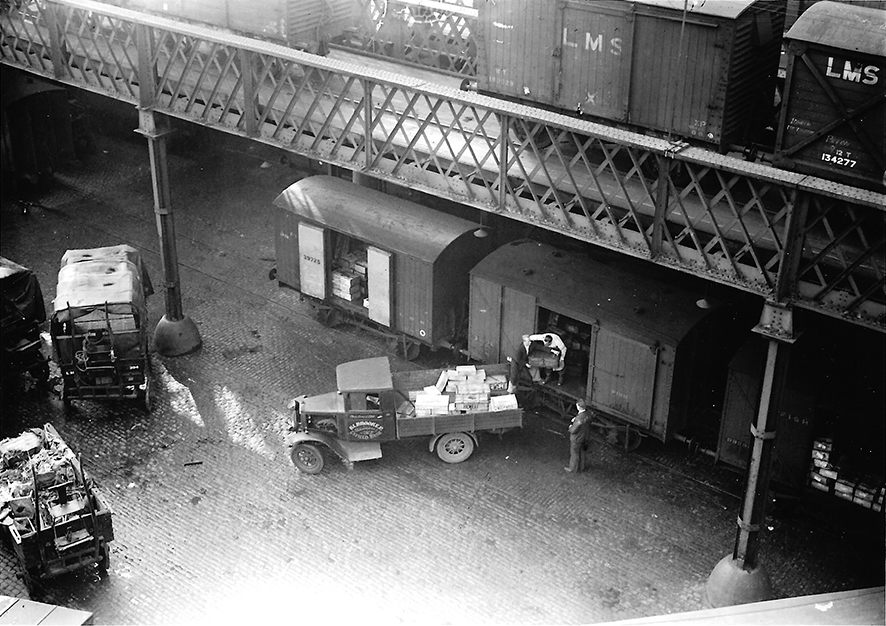
A scene at Broad Street Goods Station, now in the centre of the Broad Gate Development in London, in
October 1938, in which a lorry is being loaded with boxes. (P Tatlow collection)
The photograph above shows cases of a perishable product being loaded from one of a number of vans into a lorry or vice versa, above which is further line of vans. The light weight lattice girder viaduct connected the reception sidings beside Broad Street Passenger Station to the supplementary goods station and in fact one can just make out another similar running parallel to it, neither of which look strong enough to carry a locomotive. It is thought the photograph was taken from the accumulator building.
On the viaduct from the right is No. 134277 - an ex-L&Y 12-ton outside framed 21ft 6in long covered goods van to diagram 73(7). This is followed by LMS 12-ton fully fitted 17ft 6in long covered goods van No. 190029 with a 10-foot wheelbase, but whether to diagram D1808, D1812 or D1830 is anybody's guess(8). Finally, after a small gap, a corrugated ended vacuum piped sliding door van is just visible.
At ground level and under the viaduct, is a line of three LMS 17ft 6in long vans in crimson lake passenger livery and labelled ‘Fish' using serif lettering, all with their doors open and packages visible inside. They are from the right: partly obscured, No. 3925?, diagram D1982 one of 60 vans built 1929 at Newton Heath(9); the number of the second is indecipherable, but appears to be a similar van; and finally displayed on the inside of the open door, No 39725. However, it would appear that this number was never issued! Close inspection confirms that it has cupboard doors, vertical board sheeting, uncluttered roof, vacuum brake pipe, but brake shoes on the inside only of both visible wheels and more than a 9-foot wheelbase. In the absence of side ventilators by the date of October 1938, these features limit the field of possible diagrams to just D1886. Should this be correct, it was one of 100 built by the LMS at Wolverton in 1931/2 as a fish van and ought to be numbered within the range 39280 to 39379(9 & 10).
The lorry backed up to the middle van is a Morris Commercial L2(11). On the passenger door is painted “RL Brooke Ltd, Enfield Wash” around the edge, but the text in the middle is unreadable, while the side of the bonnet lies against the mudguard exposing the exhaust manifold. Enfield Wash is a district of Enfield in North London. The lorry contains a number of boxes, one of which is marked Hewitt and one assumes these are fish boxes in the process of being unloaded from the van.
Of the three horse drays to the left, two are fitted with tilts, one of which is LMS No. 394(12). The open cart appears to contain a random selection of junk, including straw spewing from tea chests!
In the days before computer generated invoicing etc., as well as an army of porters, carmen, checkers, etc., such an establishment required a platoon of clerks to handle the associated paper work. At a personal level, my late wife's parents both worked as clerks at Broad Street Goods in the 1920s. They met while playing table tennis and as they say 'the rest is history'.
My thanks are due to members Noel Coates, David Hanson and Niall Ferguson, together with Pat Farmer of the Morris Register for their assistance.
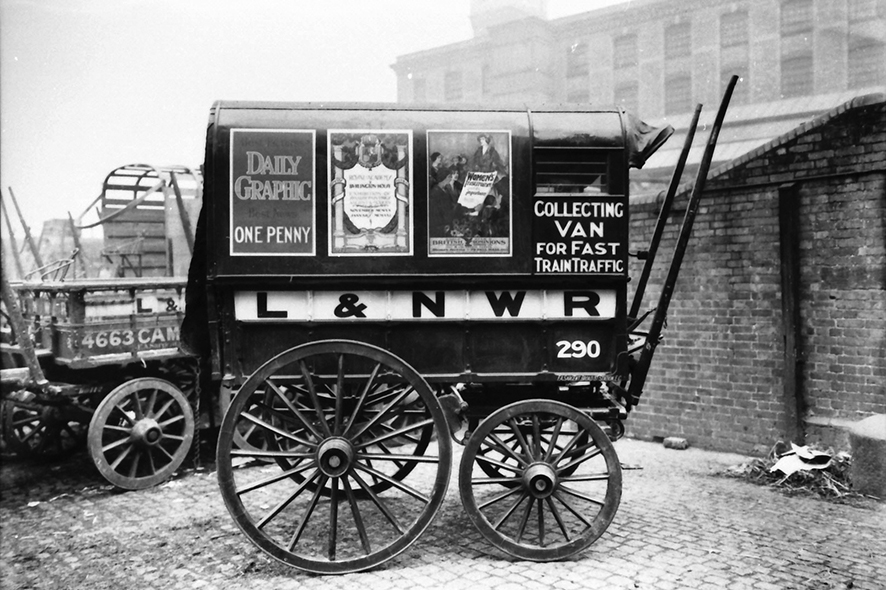
LNWR collecting van No. 290. (HMRS AAD025)
Further to the above, I have just come across a detailed description of the working of Broad Street Goods, together with other LNWR goods depots during the 1880s in William Acworth's The railways of England (14), within the chapter on the London & North Western Railway. Although starting with a description of the goods activities in the arches beneath London Road, Manchester station, it quickly goes on to describe in some detail the work of Broad Street Goods accompanied by a couple of wood block illustrations, before moving on to Camden Town and the Grid Iron at Liverpool, etc.
References:
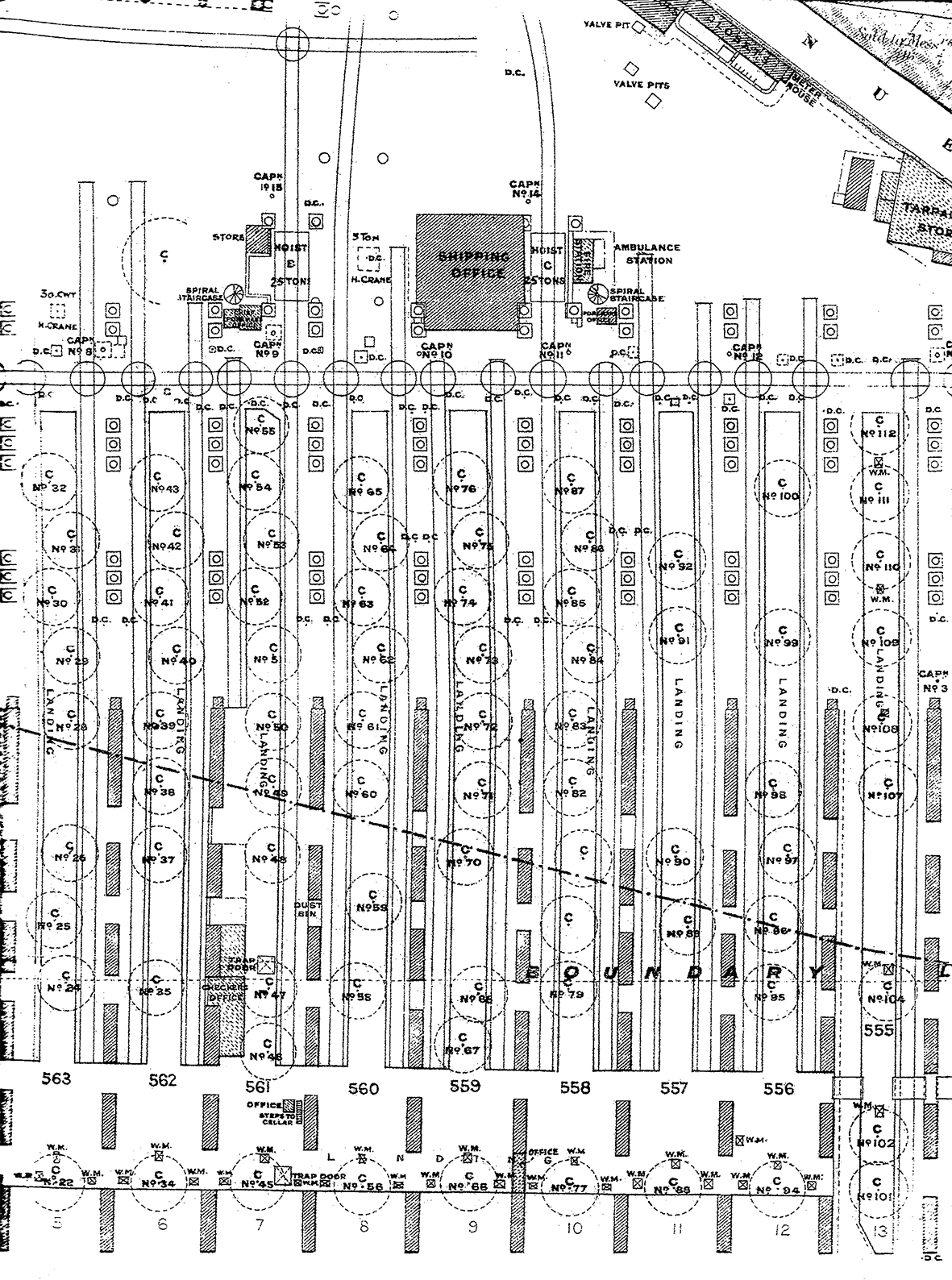
Figure 4 An extract from the LNWR 40-foot survey of 1921 showing the sidings, landing and cranes etc. within the under-croft of Broad Street station. (D Hanson collection)
Site contents Copyright © LMS Society, 2025
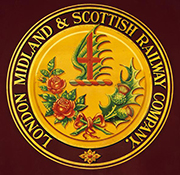
October 21st, 2025
Site contents Copyright © LMS Society, 2025